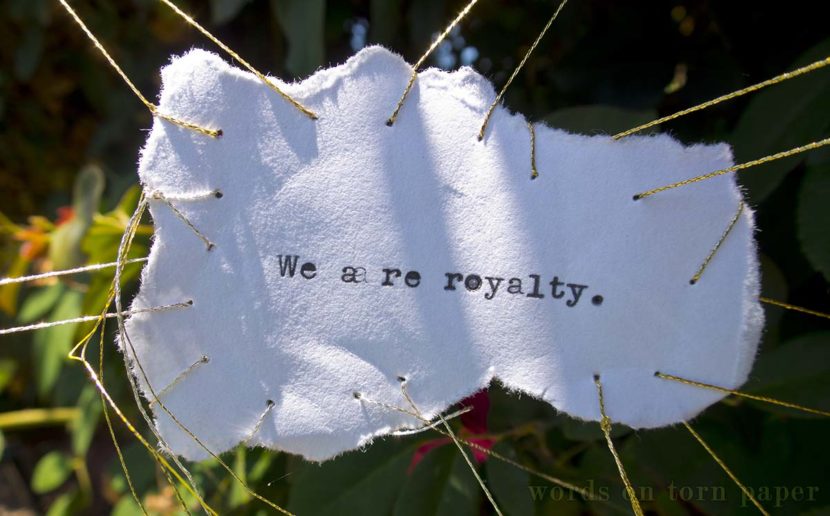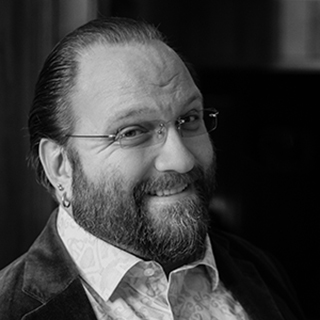 Ian Wood won’t tell you this, but he’s a man of many talents. He’s a writer, artist, musician, photographer, filmmaker, and technical wizard who exudes humor, wit, and humility. His new book, words on torn paper: Specificity is a beautiful and profound work of art and personal expression. I felt privileged to read it, and to be able to learn more about Ian in this interview. I hope you enjoy our conversation.
Ian Wood won’t tell you this, but he’s a man of many talents. He’s a writer, artist, musician, photographer, filmmaker, and technical wizard who exudes humor, wit, and humility. His new book, words on torn paper: Specificity is a beautiful and profound work of art and personal expression. I felt privileged to read it, and to be able to learn more about Ian in this interview. I hope you enjoy our conversation.
—
CM: As I said, you are a man of many talents, Mr. Wood. Let’s begin at the beginning. What is that beginning, for you? Did you write as a kid? Did you make art as a kid? What piqued your curiosity and interest as a much younger person?
IW: Kind of you to say, though I think I’m just someone who attempts many things, with varying degrees of success. I just finished reading an interview with James Baldwin where he remarked that talent is insignificant, and that he knew a lot of “talented ruins.” I like that turn of phrase.
Writing was the first thing. I had atrocious handwriting as a kid, and still do – this awful, cramped, painfully slow penmanship – so I taught myself how to type in the fourth grade, because my hand couldn’t really keep up. I started writing science fiction stories, and at some point discovered the Writer’s Digest annual, which taught me about manuscript mechanics and how to inflict my stuff upon hapless editors via the US Mail.
CM: Photography also seems to be something you love. When and how did that get started?
IW: My dad was a photographer and owned a few studios, so I always knew that was a thing people could do for a living. My parents split when I was three, though, so I didn’t grow up in the studio around cameras or anything like that. And it wasn’t a lifelong pursuit – I picked up a little red Canon Powershot in 2012 or so, and when I dropped that and broke it in 2014 I upgraded to a much fancier Canon G7X, which is what I used for the book. I half-jokingly refer to it as a “camera simulator” – it takes good photos, but it emulates many of the features of a full scale DSLR with software instead of hardware. I learned some basic principles on that, and then put myself in debt to get a Canon 5D MkIV in late 2016. So I shot the book with a point-and-shoot, and then in a burst of poor impulse control convinced myself that I needed even better gear for all the other books I was going to make. It hasn’t quite worked out that way yet.
CM: You once told me that, many years ago, you used to share your poetry at open mic nights. What, if anything, do you miss about that experience? Would you like to share one of those poems here?
IW: Probably the brash fearlessness that comes with youth and ignorance. By which I mean that it’s easier to be earnestly convinced that you’re doing something bold and new behind the mic in New Brunswick, New Jersey in your early twenties when you haven’t really been exposed to what’s out there. My performances were well-received at that venue, but I didn’t go north – to slams in New York, say, which might have been a truer test of the material. That was a once-upon-a-summer thing – every week for a couple of months, in 1994 I think. I later heard that Allen Ginsburg showed up at the café the week after I’d exhausted my material and stopped going, which was a regret-filled What if? for awhile. And many years later, during a Google ego-search, I discovered that the chapbook I’d made from the material I read that summer ended up in the Beinecke Rare Book & Manuscript Library at Yale. At one point I’d sent a copy to Michael Hathaway at the Chiron Review, who apparently saved everything he received, and my little photocopied, saddle-stapled book ended up in the collection when he donated his papers to the library. So I can rest assured that epic works of poetic genius like “Two Accounts of The Creation of A Pornographic Film” are preserved for posterity. But I think I’ll pass on sharing it here.
CM: Can you tell us a little bit about the journey you’ve taken from those early days of the open mic nights until now, with the release of your new book, words on torn paper: Specificity?
IW: Some days it’s hard for me to avoid the idea that it’s been a long, slow decline of ambition and output. I started out with big plans for novels and that sort of thing – you know, long, intensive projects of heft and import. words on torn paper arrived after most of those ambitions had fallen away…I wasn’t really writing anymore, that “brash fearlessness” was long gone, and it wasn’t even going to be a book when I started out. Each scrap of paper with fragmentary sentences and words on it was this small, desperate attempt to make something, every day. It was all I could manage, and I just lobbed each image up over the edge of this pit I so frequently found myself in, and out onto the internet. In that way the book was like a life preserver, something I could float on amidst the wreckage.
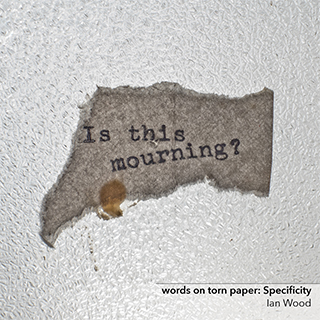
CM: Your new book is a beautiful work of art. I’m so impressed by it. I know that it’s also deeply personal and documents some of the thoughts and emotions you experienced living with depression and alcoholism. How did the idea for this book come about?
IW: Thank you, I appreciate that, truly.
The book was born of that desperation I mentioned. In May of 2015 I was up in northern California on the coast, visiting my friends and partners in publishing crime Dave and Eileen Workman (we co-own Muse Harbor Publishing), and I’d brought my friend Stephen Vessels along with me. He was starting to assemble his short story collection, The Mountain and The Vortex, which MHP was going to publish the next year. At that point he was also doing these pen-and-ink drawings, very freeform things, and he was making a practice out of it – trying to do one a day, every day. We got to talking about that one morning towards the end of our visit, and about my generally poor state of mind, and with his encouragement I thought about what I might be able to do, creatively, in that fashion – as a practice. The idea being that any act of creation – of making something, however small, and causing a small zone of order to exist where it hadn’t, before – was inherently beneficial to one’s state of mind. Whether it’s writing, painting, music – anything. I knew I wasn’t going to sit down and write a novel or a short story, even a piece at a time. I just didn’t have it in me. After thinking about it for awhile, I remembered that occasionally I would type some phrase or another on a piece of paper, scan it, and post it to Facebook. I think I’d done maybe two of them at that point…one of them was some quote from Wittgenstein, not even my own words. But I decided that I would do that, daily, for as long as it seemed necessary. The first image in the book – “Radiant” – wasn’t made with the camera, I just held the paper down on a scanner bed, probably a year before that conversation in Sea Ranch. The project grew from there. When I got back home I immediately bought the wordsontornpaper.com domain name, and set up a Facebook page and a tumblr account. The initial tagline was “words on torn paper: just that, once a day.”
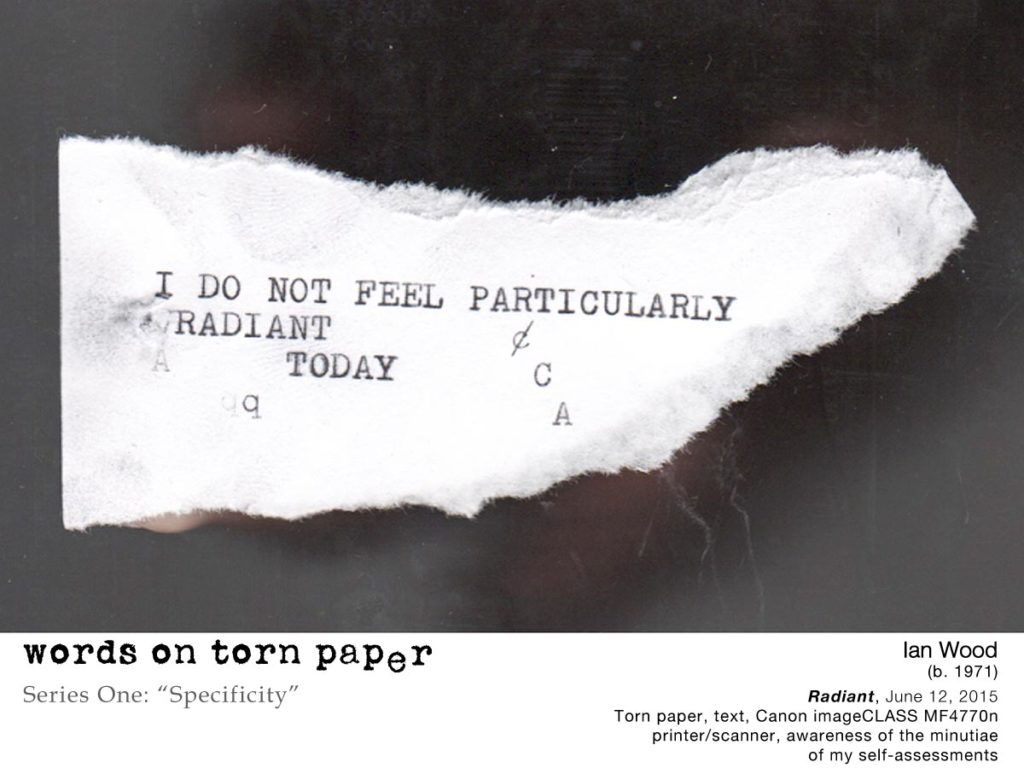
CM: What about the words on torn paper Facebook community?
IW: Well, it’s not really a community so much as a place I put stuff. Before words on torn paper became a book, it was a daily online project – I’d make the image, and post it to tumblr, Twitter, and Facebook. More to get a sense of “completion,” than anything else – it didn’t make sense to create the image and then squirrel it away on my hard drive. And there was of course the forlorn hope that it would “catch,” somehow, and get passed around. Posting on the various platforms marked the images’ publication, and I tried to get each one up before midnight on the day I made it, a real bread upon the waters kind of thing. But genuine community requires a bit of, I don’t know…communing. I don’t do a lot of that on Facebook.
I didn’t have an Instagram account while the daily project was ongoing, even though it’s photo-centric. Mostly because I didn’t have a smartphone, and also because it had a forced 1:1 ratio for the images, which I didn’t like. But they changed that, so I also use that platform for new photos, snippets of video, and some “behind the scenes” stuff.
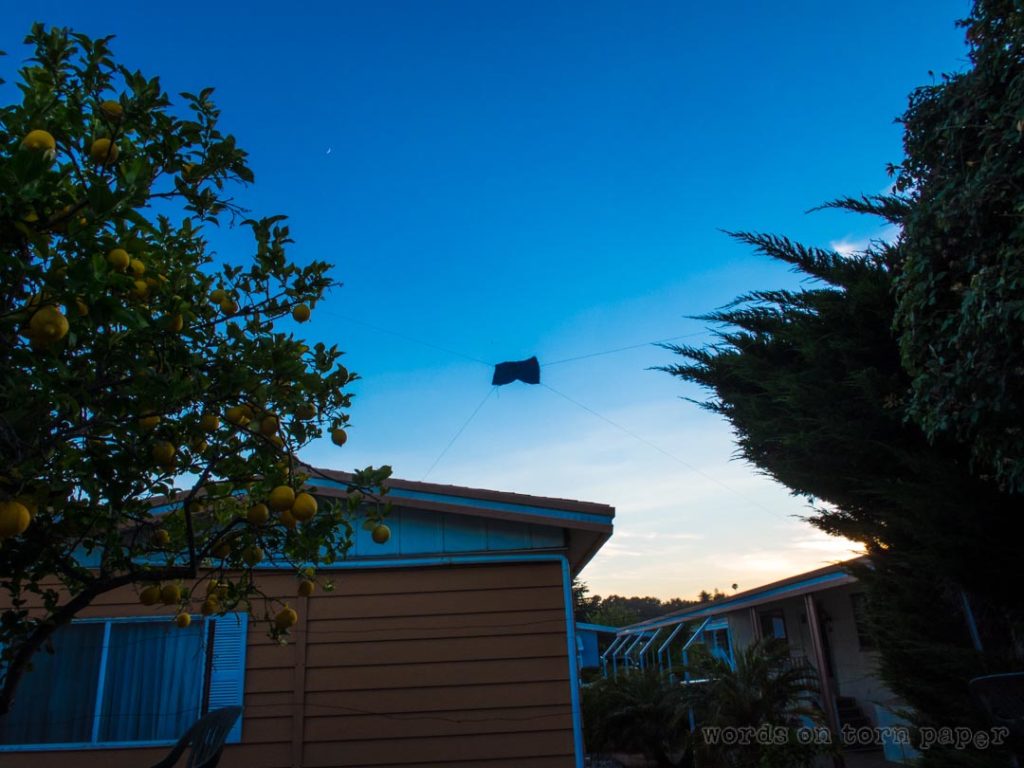
CM: What can you tell us about your creative process and your materials lists?
IW: Too much, probably. Not long after I started taking the photographs, I came up with a couple of “rules.” The photo had to be completed, processed, and posted by midnight on the day it was made. Once I’d typed the words onto the paper, and took it “on set” – that is, put it wherever I was going to shoot it – I had to use it as it was, I couldn’t go back to the typewriter and make a new one. This kept me motivated, or as motivated as I could be at that point in my life, and also prevented me from “editing” too much. It also forced me to work with what I had – almost every photo was taken in or around the house, because if I didn’t get the words typed until the late afternoon, I didn’t have time to drive around looking for an interesting place to put them. Whatever nonsense I typed, I committed to – it was my version of Ginsberg’s “first thought, best thought,” though “best” is debatable. A couple of them, once finished, were uncomfortable to put out into the world…and in those cases, I took David Bowie’s advice – “If you feel safe in the area you’re working in, you’re not working in the right area.” That became more important when these one-offs, the full series of 90 photographs, began to coalesce into a book, because while I was making them I couldn’t really see any overarching theme, but the story that they suggested when viewed together as a body of work wasn’t entirely comfortable for me to look at. While I was in the thick of the process, I was following this obsessed sort of aesthetic intuition – got to type the words, got to set up the shot, got to process and post by midnight, every day, wash, rinse, repeat, for about three months. Afterwards, I saw that I’d actually assembled an unintentionally revealing – to me, anyway – self-portrait. But I don’t think I could’ve done that if I’d set out to do that.
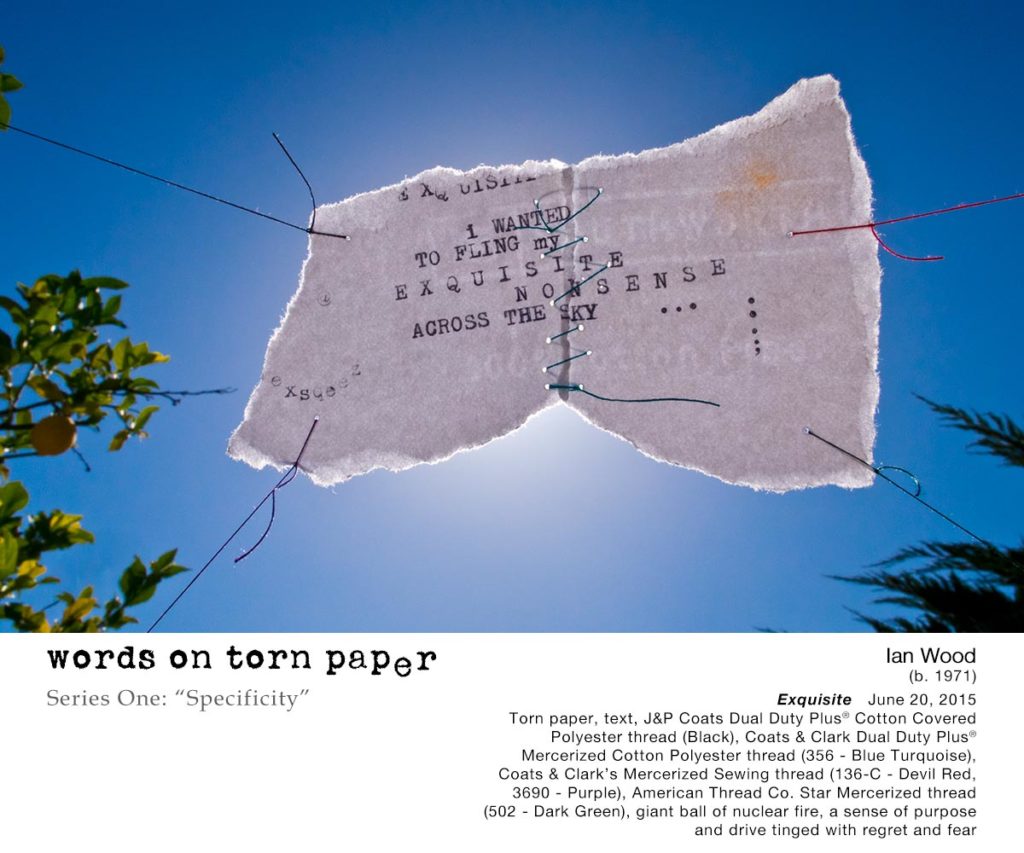
The materials list came about two months into the process, when I realized that when I was done, I’d have…something. I wasn’t sure what. But the conceit there was to create an object card for each image, like you’d see next to a painting or photograph in a museum, that lists the title of the work, the artist, and the materials used. When I’d finished, and each shoot was still fresh in my mind, I spent a couple of days going through all 90 images and wrote a description of my state of mind on the day I’d taken each photograph, treating that as a material, along with the bits of paper and whatever else I’d used as a “set” or props for the image. As that notion developed, I decided I had to commit to it, so some of the last things I did during the book design were pull the television out of its place on the shelf and get the model number off the back of it, and write down the item numbers from the spools of thread I used, and so forth. I went through and added every registered trademark and copyright symbol to the products I used, because that was the most precise and proper name of that object. That’s where the :Specificity part comes in – everything else about the images and the words seemed so decontextualized and ambiguous to me, and it made an odd sort of obsessive sense to make every other aspect surrounding them as particular as possible. So really each piece in the book consists of the photograph, the object card, and the background of the two-page spread. Taking the physical materials from the object cards and putting everything together in the list at the end was a silly coda…Here are the ingredients if you want to make your own.
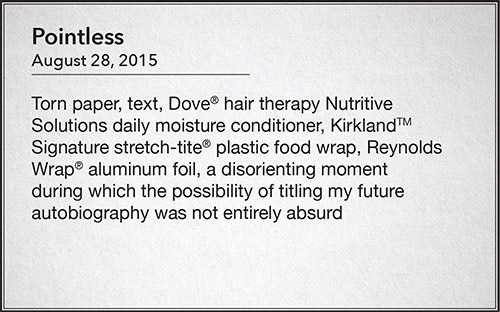
The final part of the book design was driven by the practical needs of the square book format – the photos are all 1:1.618, and I’d wanted a landscape format, but the printer wasn’t offering that format at the time. So I had the photos, with the object cards on the facing pages, and all this white space, which looked terrible. By that point I was more aware of the project as a form of communication – sort of yelling from inside my skull out to the world at large – and I had a scanned collection of typewritten letters I had randomly mailed out to various people in my life, back in 2014. And because I was dealing with the same stuff that year – the depression, ever-increasing alcohol consumption, a pesky pill habit, and so on – it seemed a fitting way to “frame” each two-page spread. There are only a few spreads where I chose a letter that was contextually relevant to the photograph, mostly I followed the same sort of aesthetic intuition I’d used while taking the photos. I’d pick a letter that felt “right,” then rework the text in Photoshop so that the words become these abstract design elements.
All of which probably sounds overwrought…I don’t want to give the impression that the book was somehow planned with that level of detail; it evolved from a place of feeling unable to do anything in the world at all, into something that’s vaguely coherent almost in spite of itself, with multiple layers in it.
CM: I love the book trailer for words on torn paper: Specificity. How did come up with the concept for “Arrival”?
IW: Mirrorface is this uncanny gentleman (I’m assuming, based on the suit, though I could be wrong) who first showed up in the little announcement video I did for the website launch in 2015. I guess the most concise way to describe him is that he’s Not From Around Here – he’s got this odd way of moving, he bops in and out of sight, that sort of thing. My impression is that his notion of what’s important or valuable is probably a bit different from most people’s. For him it makes perfect sense to steal cardboard boxes from my porch, and leave their contents. Which I appreciated – that was an expensive book order.
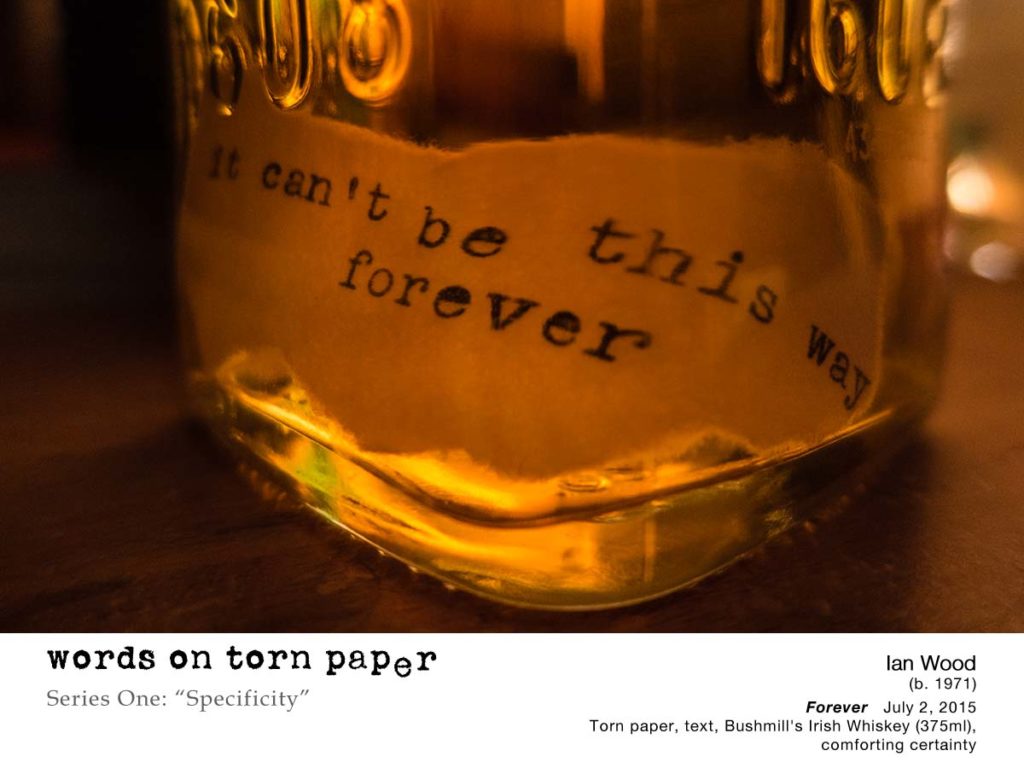
CM: One of the images in words says “It can’t be this way forever.” Can you talk about what that sentence means to you today, and its significance at that time in your life? How important do you think it is for those who may be struggling to remember that “this too shall pass?”
IW: Well, those words are literally soaking in the issue of that particular day. By that point I’d committed to drinking professionally…almost with this weird kind of self-destructive integrity: If you’re going to do this, you’re going to do it properly. At the same time I knew that I couldn’t do that forever, but I wasn’t at all sure what my way out would be, or if I’d find it at all. I was more or less functional in a practical sense – I could still take care of my mom, and do most of the other household things – but all of the frontal lobe changes and erratic emotionalism that happen with chronic exposure to alcohol were becoming increasingly apparent to me. So on the one hand, I was engaged with this project, but on the other, my life was definitely not on an upward trajectory, and I was still rationalizing the hell out of it. That’s part of the discomfort in putting it all out there, even if it’s somewhat obscured – if you look, you’ll see a very fucked up individual. That can be difficult to show to people. But, you know…Bowie.
I took that photo – “Forever” – in early July of 2015. The following May I started self-administering naltrexone, and over the next several months used the Sinclair Method to quit drinking. During the period between July of 2015 and May of 2016 I reached 305 pounds – just mountainous, it was a terrible thing – and I was drinking so much that I’d regularly get these horrendous leg cramps. With appropriate pacing I could go through a bottle of whiskey a day two or three times a week, and I needed a drink immediately upon waking just to get to baseline. Now, I’ve lost 55 pounds – still trending downwards – and am a non-drinker, with normal liver and renal function, and I’ve gotten all the rest of my bloodwork results back into their normal ranges. I found my way out. But on the day I took that photo, all I knew was that I needed to make a change, and that I’d gone about as far as I could go living my life the way I was. I had the intention, and to my mind that’s the first and most vital step towards enacting any change at all. You’ve got to know where you want to go, even if you don’t know how to get there.
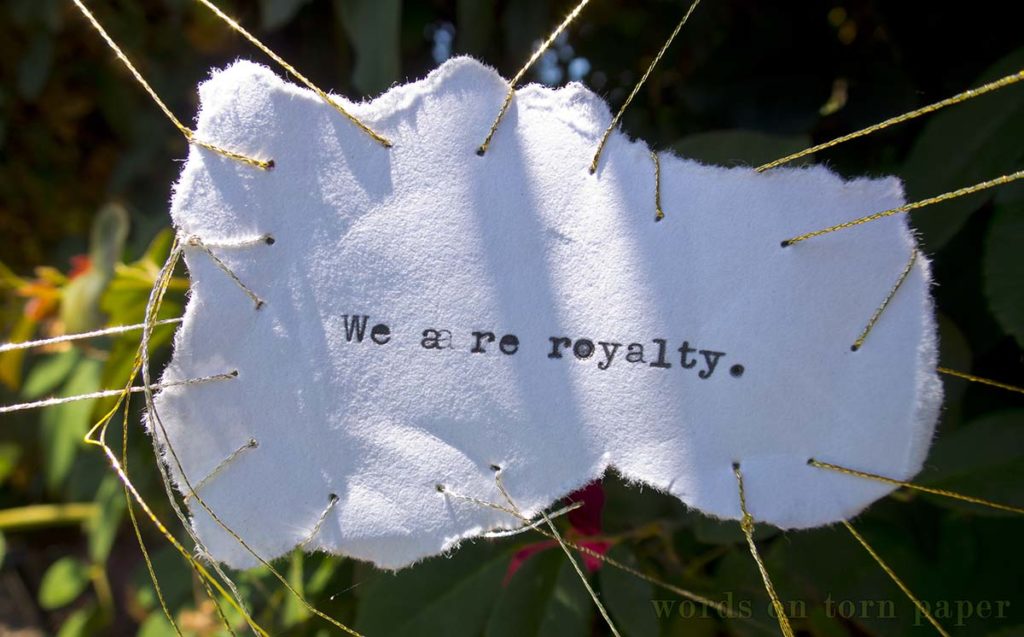
CM: Can you please tell us about the image “We are royalty.”?
IW: I can – that one was a response to the previous day’s image (“We don’t want to be shattered but we are.”) There’s not a lot of crosstalk between the photos, but for some reason I felt the need to respond to the bleakness of “Shattered,” with the idea that even though just being alive can batter and break people, we all still wear these glittering crowns of consciousness in the dark.
CM: Another one of your images reads “I continue to labor under the assumption that this is meaningful.” Is it difficult for you to view your work as meaningful? What do you want this book to mean? What do you hope others take away from it, and particularly those who may be dealing with depression, substance abuse, or other challenging life circumstances?
IW: It’s certainly meaningful to me, even if that meaning was something that gelled over time as I got some distance from the three months when I was taking photographs every day. As far as what I might want it to mean to other people…well, we’ve had conversations about this, it’s a really difficult question for me. Part of that comes from the nature of the work, which wasn’t produced with any intention other than the doing of the thing itself. It wasn’t even going to be a book, and once it was, it wasn’t immediately apparent what kind of book it was (and still isn’t, to me). I’d accidentally created a self-portrait in 90 photographs, or a 90-day memoir. It’s a depiction of a difficult time in my life, when I was on the cusp of making necessary changes, but by the time I took the last photo in the series, I hadn’t yet made any of those changes. There’s no happy ending, no lessons imparted. Which doesn’t mean that it’s all doom and gloom – there’s some funny things in it, some bizarre or silly things, but there are funny, bizarre, and silly days even in the midst of depression, which don’t deflect the arc of that experience.
One way I’ve thought about depression is that it’s an extreme form of self-involvement. And I don’t mean that in the malignant, narcissistic sort of way. It’s just that every little thing about daily life, the smallest action, looms incredibly large in one’s perception, and takes on this massive subjective weight that’s difficult for other people to see or understand, from the outside looking in. It’s a distortion of perception, where ordinary things like brushing your teeth or taking a shower become near-insurmountable burdens, and the future in general seems impenetrably complicated. That self-involvement is very much in evidence in the book, I think – there’s a reason the dedication page says For me. It was something that I had to do, for myself, first to have that little daily instance of creativity, and then as a project to finish, to finally get something of mine completed and out into the world.
At the same time, it depicts a kind of progress. There’s movement. Part of the package of depressive self-involvement is this boundless sense of unique despair, that No one else can possibly fathom just why it is that I can’t manage to do the fucking dishes, again. And it’s not unique. It’s a human experience. Not everybody goes through it, and those who do go through it experience it in different ways and to different degrees. So, while it’s difficult for me to ascribe intentionality to something that was made in such a deliberately unintentional way – if that makes any sense at all – perhaps the sole value it has, in that context, is that it’s a true description of a certain kind of experience, in which other people in similar circumstances might see their own experience, and feel less alone in that place. Maybe it suggests that there’s a way out, even if it’s just a tiny thing you do every day.
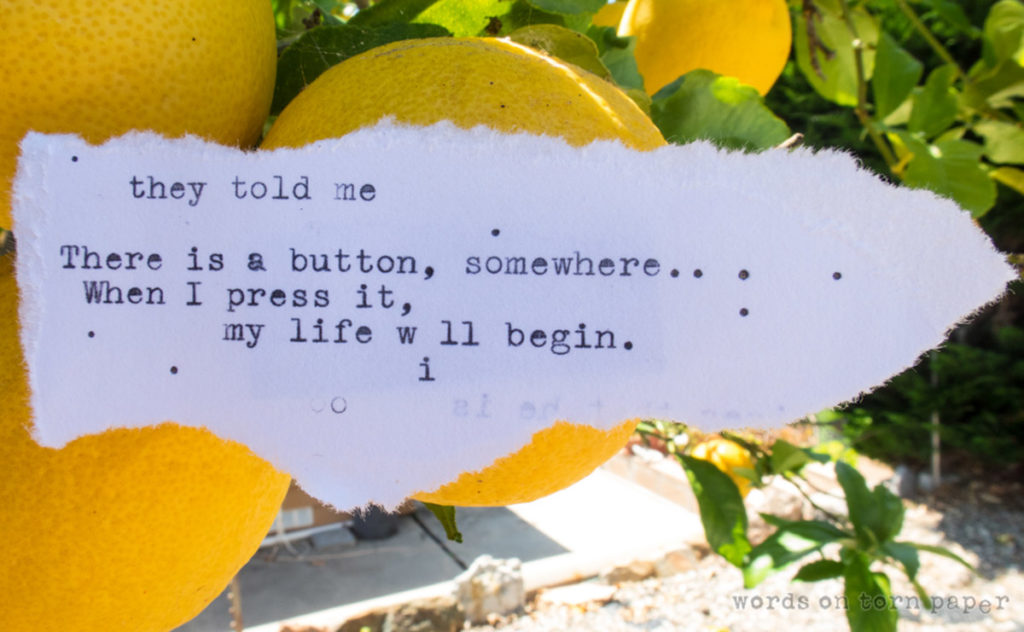
CM: Where can people learn more about the book? Where can they purchase it?
IW: There’s the project site, www.wordsontornpaper.com, for more information. It’s available in hardcover and paperback on Amazon, and you can order it from most bookstores as well. Although now’s a good time to get it from Amazon, because their algorithms have cut the price quite a bit (the paperback pricing is currently in beyond-the-remainder-bin territory).
CM: Does the words on torn paper project continue? Have you noticed that what you are drawn to capture these days has changed? If so, how?
IW: As the book was coming together in early 2016 I was still taking photos, with vague plans for a second series tentatively titled “sign & portents,” most of which you can see in a slide show on the project site. But making the move from that daily, first-thought-best-thought, intuitive process to something more crafted and planned out proved to be a challenge. I still produce the occasional photo as the mood strikes me, which isn’t often. I have a couple of ideas for photos kicking around, but now I think about them for a much longer time. It’s a different way of working, and I’m not quite sure how I feel about it yet. I find that there’s an marked ebb and flow to my creative process, where I have to rest and gather my energies after producing something, and I try not to repeat myself too much, so I’m not certain where I’ll take words from this point. New stuff, when it happens, still appears on Facebook and Instagram.
CM: I know that you are also working on a performance piece called Fat Man On Gibraltar Road. What can you tell us about the show?
IW: Fat Man On Gibraltar Road is a video series documenting my attempt to 1) Lose 105 pounds, 2) Pedal up Gibraltar Road on a tricycle, and 3) Not die. I started it in August of 2016 with this idea that I’d do these five- to seven-minute video journals as I was training to ride my recumbent trike up Gibraltar Road, which is a steep road that runs up to the ridge line above Santa Barbara – 6.6 miles, with about a 2,700-foot gain in elevation. Pro cyclists use it for mountain stage training. Calling it a “performance piece” was a bit tongue in cheek, on my part – I’ve only completed two episodes out of a planned ten, so it’s also become a documentary about procrastination and how difficult it often is for me to get anything done. But when it’s all together, the long time between episodes will mean I’ll get visibly thinner over the course of 60 minutes or so, which might be interesting. We’ll see.
CM: I started by saying you are man of many talents, and I know those talents include web design and other technology skills. What exactly is Crackle Factory and what services do you offer?
IW: I offer “Technology consultation for creatives,” everything from website design and hosting to getting your e-mail set up on your iPhone.
Over the years I’ve noticed that many of my creative friends – artists, writers, and musicians – seemed to have a fraught relationship with technology, whether it was the internet in general, their smartphones, or their laptops. I also noticed that many of the companies and consultants that offer technology services weren’t really coming from a place of understanding just what art is to an artist. The whole “left brain/right brain” thing is a 19th-century myth that’s not really supported by modern neurology, but there is often a very real difference between how tech-savvy people communicate, and how artistic or creative people communicate. There’s this sense that programming or website design is arcane knowledge, which can be intimidating to the “uninitiated.” I’ve got a background in technical writing, which is fundamentally the process of explaining how software or hardware works in the clearest way possible, and I’ve also got an artistic sensibility. Any project I take on begins with the client’s art: what are you creating? What do you want to do with your creation? I try to bridge that gap between the insistent demands of technology-driven commerce and the artistic process by keeping the focus on what’s most important to the artist, which tends to be (surprise!) their art. It’s still a new venture, for me, but so far my clients seem pretty happy.
CM: What has the experience of creating and releasing words on torn paper taught you about yourself and your art?
IW: I tend to be pretty hard on myself, so my lessons always seem to be something like “I’ve learned a lot, mostly about how much I don’t know.” That kind of quashes any sense of accomplishment, which is annoying; I should stop doing that. That said, this particular burst of art is almost a side effect of the positive changes that I was making in my life while I was producing it, and the dust hasn’t settled from all that, yet. But it all started from a small, simple notion: creating is good for me. So I should probably keep doing that, right?
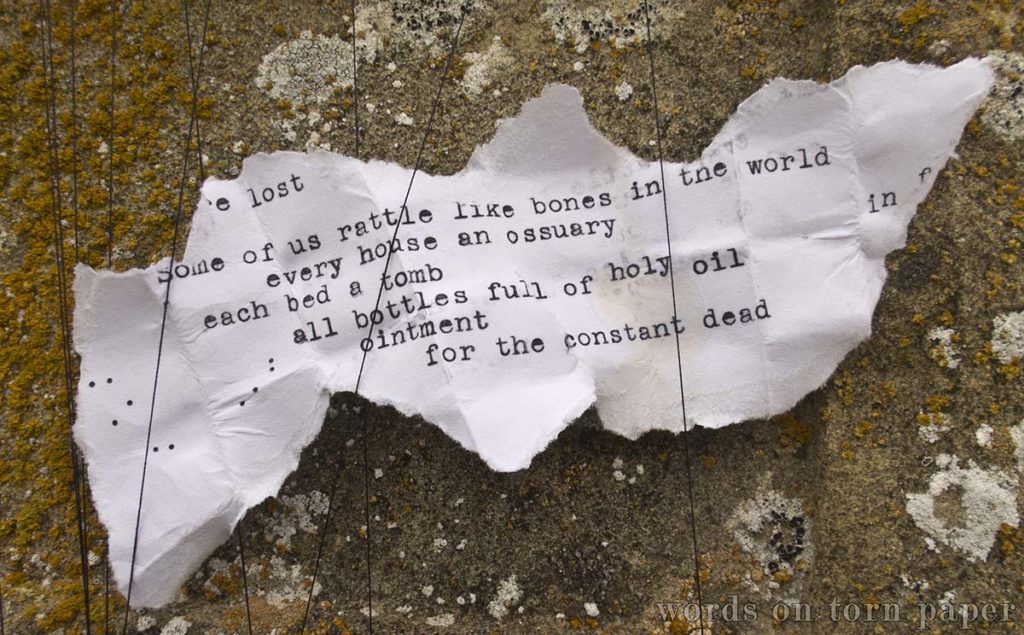
CM: If you could photograph a words on torn paper image today, in this moment, what would it say?
IW: “Under the present circumstances…”
CM: What do you want to do next, as a writer, as an artist, as a human?
IW: I’m still cleaning up wreckage – there were a lot of intense, complicated, stressful life situations that broadsided me, starting in 2012, even apart from incipient sobriety. I don’t feel like I’m back on track yet…in fact, I have to build a new track before I can get on it. That will be easier with a clear head, but I still have a lot of work to do.
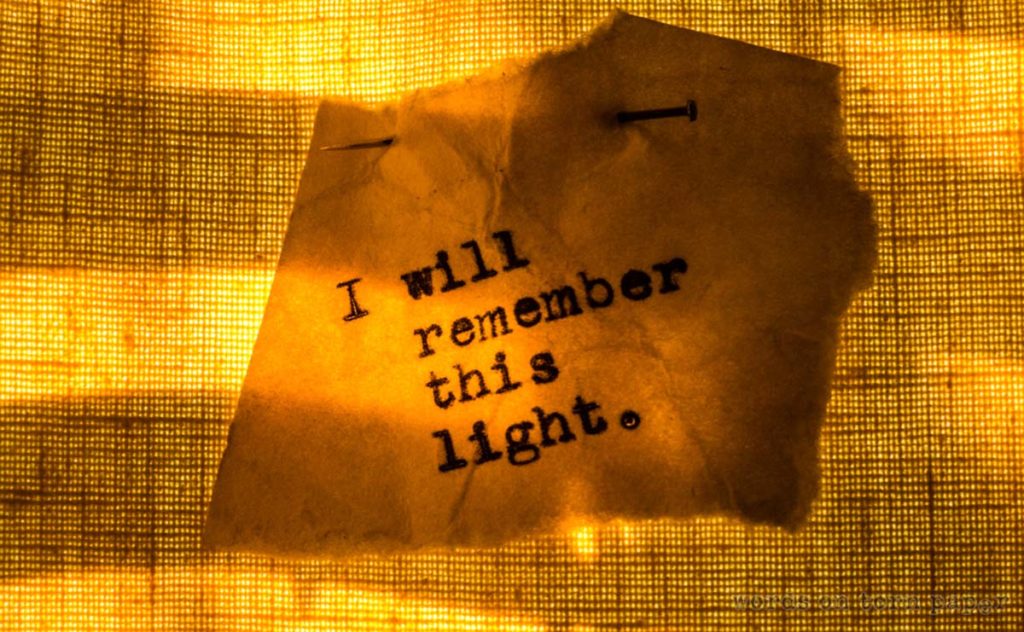
CM: Where can people learn more about you?
IW: I’m between websites, at the moment – I’m still building the Crackle Factory site, and my personal artist’s site is a registered domain and not much else. It’s a real “cobbler’s children have no shoes” situation. For now, the wordsontornpaper.com project site is the best place to find me, though even that site is old and creaky at this point.
CM: Anything else you’d like to share?
IW: Oh, I think I’ve babbled on for long enough! Thanks very much, this was a great thing.
CM: It has been my pleasure. Best of luck with words, and with all that is yet to come.
To purchase a copy of words on torn paper: Specificity, click here.
To connect with Ian on Facebook, please check out the Facebook page for words on torn paper: Specificity.
To learn more, please visit the words on torn paper project site.
PLEASE NOTE: The opinions, representations, and statements made in response to questions asked as part of this interview are strictly those of the interviewee and not of Chloé McFeters or Tortoise and Finch Productions, LLC as a whole.

